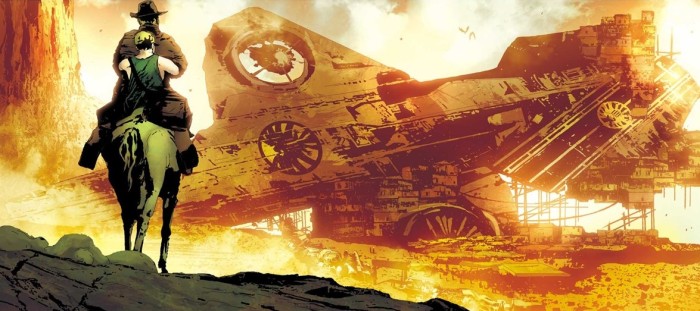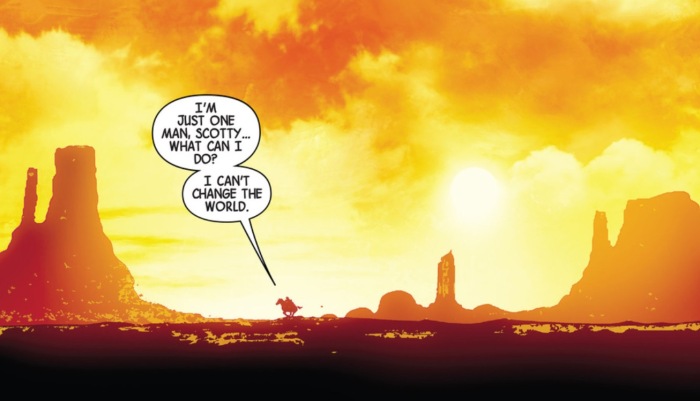
What’s the most egregious evil, the most rancorous rot on the most sinful soul? Many say the worse villainy is born from the same stuff as the greatest heroism; men who are the protagonists of their own stories, who bear the deep conviction regarding the rightness of their actions. They are great men. Terrible, to be sure, but no less great for it. And yet any man who commits evil under the belief that he’s doing good – whether defined as right action in itself or acquiring a better future for his country, his family, even himself – has not yet left reason fully behind. His goals, while wrong, are still rational, and thus exists a starting point for dialogue, that he might be persuaded off his pernicious path.
Not so with petty cruelty, the kind depicted here in Old Man Logan #1. It is evil as an ends in itself, without reason or reflection. It does not even rise to the level of Sadism, whose sexual salaciousness can be sated or suppressed. No, petty cruelty is subhuman, the devolution of a person to primate, their thoughts primitive, their urges primal. The deed in question is hardly an injury even: a geriatric supervillain named Black Butcher seizes Logan’s son’s cap, brazenly backhanding him with the knowledge that the former Wolverine wouldn’t retaliate.
Butcher is a bully. Genocides have been committed towards the cause of eugenic perfection. More multitudinous mass-murder yet has been carried out in pursuit of economic egalitarianism. Yet as ignoble of pursuits as ethnic purity or socialistic society are, more misguided yet is such purposeless pilfering, such pointless pummeling. Black butcher had no need, perhaps not much of a want even, for young Scotty’s hat; he took such because there was no shred of conscience left to hold back his hand.
“His body hits the floor and everything feels right. I know a peace I ain’t felt in a long, long time. I’m sure now this is why I’m here. I’m here to hunt.”
Such is Logan’s inner monologue as he butchers the Butcher. I’ve always been of the Superman school: Justice, not vengeance, is the way of a hero. And a retributive justice at that, one which limits itself to punishing the deed done and no more, not even as a deterrent. Moreover, even for the Doctor Dooms and Magnetos of the world, redemption is possible. And yet, I cannot fault Logan, cannot condemn the execution, any more than I could condemn a man for taking an old rabid dog out back with a shotgun and putting it out of its misery. It’s only sensible such a savage beast should be so slaughtered.
This seemingly small story of revenge proves the perfect setup for the series to come. Removing his claws from the Butcher’s skull, Logan crosses off the villain’s name from a list he’d written on his forearm. Three more remain: Banner, Mysterio, and Red Skull. It is at this point Jeff Lemire’s direction for Old Man Logan becomes clear. Unlike the Secret Wars tie-in by the same superstar team of Lamire and Sorrentino, this series will certainly have strong ties to the original arc by Miller and McNiven. As such, the Marvel-616 setting is not an incidental editorial decision, but the perfect period and place for Logan to extract revenge in reverse. In this sense, Logan is Marty McFly with razor sharp claws and a lot less fucks to give. I’m sold on that premise.
I’m also sold on the art, both Andrea Sorrentino’s pencils and Marcelo Maiolo’s equally important colors. Such hardly comes as a surprise. The same creative team worked on the seminal run on Green Arrow a few years back, who’d prior to their take been my least favorite character across DC and Marvel. By the end of their eighteen issues together, I’m now willing to follow them to a Ma Hunkel/Madam Fatale ongoing team-up if they so choose.
Together they’ve perfected onomatopoeia in comics. Sound-effect rarely add to the visual value of the art or aid so much in the story-telling that their inclusion is necessary; The Ultimates omitted such entirely and was better for it. Yet Old Man Logan, like Green Arrow before it, shows onomatopoeia done right. A well placed “KZZZZZT” and a generous heaping of “SNIKT”s add an atmosphere that even the most visceral visuals could not (though the visuals are indeed plenty visceral).
Undoubtedly, the best scene comes at the bottom of page sixteen. In a flashback to a future that will now never come, Logan is riding across a sun-kissed canyon with son Scotty saddled behind him, both bitter at Black Butcher for the bully’s cruelty on the previous page. When asked by his boy why he just walked away, why he didn’t stand-up and fight back, Logan replies, “I’m just one man, Scotty. What can I do? I can’t change the world.” Such perfectly plays with the reader’s knowledge; we know that he can indeed change the world because in Miller and McNiver’s original Old Man Logan that’s exactly what he did. Such a defeatist dialog is, in context, an excellent and empowering exhortation by Lamire regarding the proper response to cruelty of all kinds.

9.0/10



Pingback: X-Men: Apocalypse | The Hub City Review